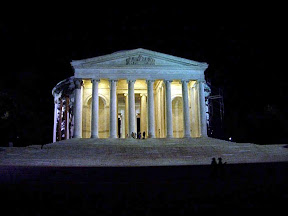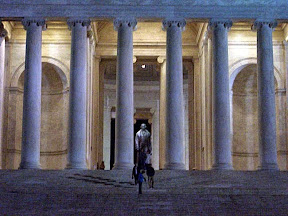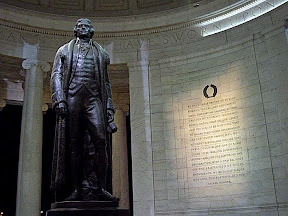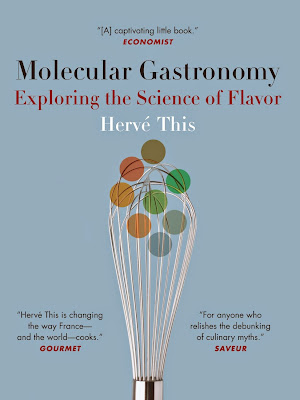For August, the Kitchen Reader online book club assignment was Thomas Jefferson’s Creme Brulee: How a Founding Father and His Slave James Hemings Introduced French Cuisine to America by Thomas J Craughwell.
First, I have to say that the title and description on the book jacket of this was totally misleading to me. In advertising it as a deal between Thomas Jefferson and his slave James Hemings and how they studied and brought French cooking and crops to America, I thought I would be reading both about what Thomas Jefferson contributed as well as what James Hemings contributed.
Instead, the narrative history sticks much more as the side stories that you might hear from a history professor in telling interesting facts here and there from that time period, tying them loosely together based on the chapter. There are many pages of the book which are about neither Thomas Jefferson or James Hemings but a great detail what it was like to generally be living in that time either in the United States or in France, and even a little pre-history of how that way of living came to be too.
I appreciated the rich context that it gave to some of the interesting facts, but it also became a lot of noise as well, sort of if that history professor was drinking whiskey with you and would go off on these long tangents before coming back to the story.
The result was on one hand, I did enjoy some of the information that I learned. On the other hand, there were times I felt like I was being forced to get through sections politely, and it was as dry as assigned reading given as homework. Although the book provides limited information on James Hemings, you can find a bit more here on the Monticello website.


Lucky for you, I’ve decided to pull out some of what I thought was the best stuff.
We start off in the book when Thomas Jefferson, who by the way if you didn’t know was not only a founding father but a great lover of food, is first assigned overseas. You also learn about what dining is like in America at this time and France.
Food at this time was cooked by women, many of them slaves, with an open hearth. The food itself consisted mostly of meats (salted, seasoned with garden herbs and very few spices are used, roasted, boiled, baked or stewed), overcooked vegetables, breads, and heavily sweetened desserts.
An example of some colonial food: These two appetizer dishes below. One is a baked brie en croute in puff pastry stuffed with cardamom spiced apples and finished with raspberry coulis and sprinkles of cinnamon and sugar. The other are hot smithfield ham biscuits with mascarpone cheese and raspberry puree dip. Both of these dishes are example colonial dishes which I had a chance to try at Gadsby’s Tavern (which specializes in a colonial experience) in Alexandria, Virginia.
This sounds crazy now thinking about how plentiful the colonies’ seafood access could be, but except for sturgeon and oysters, no one ate it! Clams and mussels were fed to pigs, and governor of the Plymouth Colony in 1662 William Bradford lamented once about having nothing to feed the new colonists but all lobster. As late at 1796, the author of the first published American cookbook Amelia Simmons suggested garlic, though used by the French for cooking, was only suited for use as medicine. Plain food was seen as a virtue, and as honest. Hospitality was based on abundance of food, not flavor.
This is different than in France, where a culinary renaissance had moved from the cookery of the Middle Ages reliant on spices and sugar to stocks and sauces to build layers of flavor. Rather than trying to fill the table to brimming with options, serving meals in courses which were a progression was the process for a meal. It was also in Paris that the word restaurant changed from a place that sold restoratives like consommes and bouillon to offering food. Before this, the only restaurants as we know today were inns and taverns. In Paris, the city apartment-dwellers who did not have kitchens also helped encourage the boom of retail food shops.
In a fun little fact, even though potatoes were brought back by the Spainards from South America in the 16th century, it was not until 1785 that potates accepted them as safe to eat. The convincing came from a sly trick where Frenchman Antoine-Augustin Parmentier schemed and had 40 acres planted with potatoes and then guarded by troops. The fact this was guarded made the local people curious and so they stole them and ate them and so started the potato craze. The pomme frites of France would later travel with Thomas Jefferson and James Heming as french fries.
We also learn in the book that the slave to turn apprentice chef James Heming is a slave, but is also actually one of the half-siblings to Martha, Thomas Jefferson’s wife (who has already passed away at the time of his overseas appointment). Upon his father in law’s passing, the Hemings family of slaves/half-siblings were then inherited by Thomas Jefferson.
Slavery is unknown in France, and so any black person, including James Heming , could have claimed his freedom. Thomas Jefferson paid a generous monthly salary to James Heming while he lived in France, gave him freedom of movement, and promised emancipation at the end after he returned to America with him and taught the skills he learned to apprentices (which it would turn out, would be his brother).
In the end, some of the dishes that James Hemings mastered for Thomas Jefferson have since become American classics: French Fries, Creme Brulee, and Macaroni with Cheese! These were among the humbler dishes that had easier recipes to teach to apprentices. Jefferson’s recipe is the earliest recorded recipe for ice cream as well. Thank you Thomas Jefferson and James Hemings!
For 4 months, Thomas Jefferson took a special grand tour by carriage to visit farms and wineries, scouring for local ingredients to take back home to America. Things he collected and introduced back in America (and in some cases smuggled back) included Champagne and other French wines, Italian rice, Olives, Capers, Almonds, Pistachios, Broccoli, Figs, Parmesan, Maille mustard, apricots, a pasta making machine, and more. He brought back plants including cuttings to grow wine, and cork trees to have stoppers on hand when he bottled his first vintage. Jefferson journeyed with a corkscrew in the same little case he carried with him that held his toothbrush.
He also brought back a new way of serving dinner in which servants presented serving dishes but then left the room, leaving guests to serve themselves, a process in which he believed encouraged open conversation. On multiple occasions, the book refers to various parties of opposing views meeting for a meal at Jefferson’s and that the cuisine and wine put men in an amiable and reasonable frame of mind to negotiate and unite on measures.

There were other little tidbits of stories as well- as a widowed father for instance, how he tricked his remaining middle daughter that he had left in America after his youngest died to come to France. He had her and her friends play on a ship as long as she wanted, and when she fell asleep her friends left and the ship took off for France! Later, when his oldest daughter wanted to join the Catholic nuns, he took her shopping and let her attend balls and other entertainments, and she abandoned the thought of changing religion and becoming a nun. Yes, Thomas Jefferson was skilledb at negotiating the complexity of politics and daughters!
If you’ve read this book before… do you agree that these were parts you found interesting? Was there a unique side story that I missed?
For September the selected book subject is Molecular Gastronomy: Exploring the Science of Flavor (Arts and Traditions of the Table: Perspectives on Culinary History) by Herve This.
Interested in joining us? All you have to do to join our book club is sign up at the online book club Kitchen Reader, read the book (or part of it) and post your thoughts on your blog during the last week of the month.










You are definitely right that this book was wide-ranging. I learned so much about Jefferson that I didn’t even know I didn’t know! I wish I had learned more about Hemings instead. I wasn’t sure if Jefferson was a good father or not, some of the stories about his daughters mystified me.